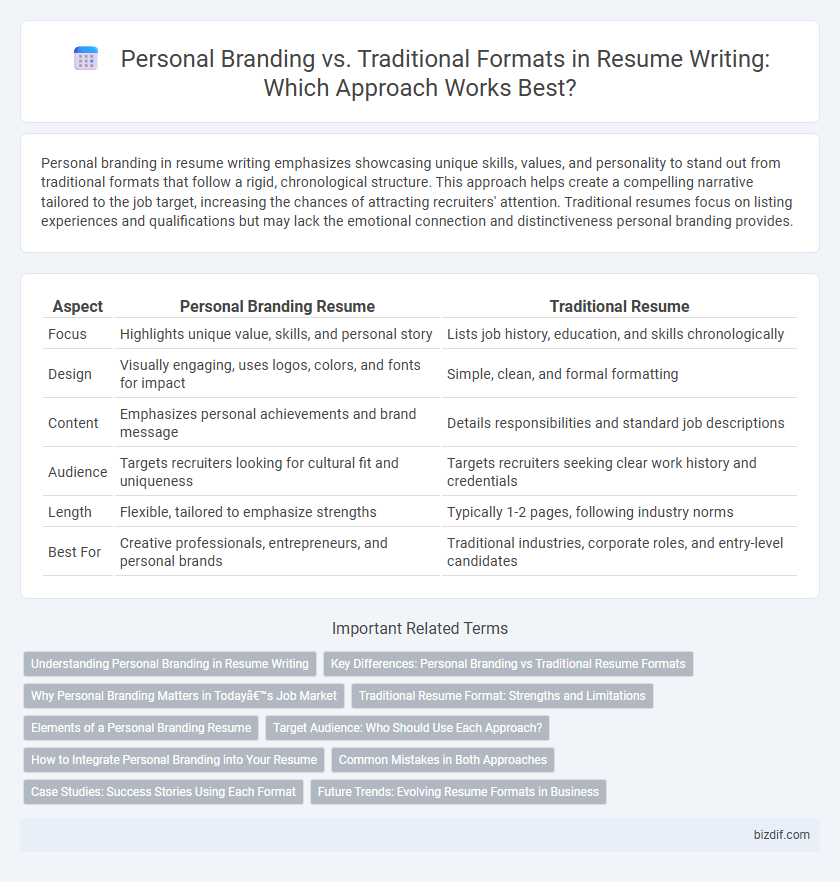Personal branding in resume writing emphasizes showcasing unique skills, values, and personality to stand out from traditional formats that follow a rigid, chronological structure. This approach helps create a compelling narrative tailored to the job target, increasing the chances of attracting recruiters' attention. Traditional resumes focus on listing experiences and qualifications but may lack the emotional connection and distinctiveness personal branding provides.
Table of Comparison
| Aspect | Personal Branding Resume | Traditional Resume |
|---|---|---|
| Focus | Highlights unique value, skills, and personal story | Lists job history, education, and skills chronologically |
| Design | Visually engaging, uses logos, colors, and fonts for impact | Simple, clean, and formal formatting |
| Content | Emphasizes personal achievements and brand message | Details responsibilities and standard job descriptions |
| Audience | Targets recruiters looking for cultural fit and uniqueness | Targets recruiters seeking clear work history and credentials |
| Length | Flexible, tailored to emphasize strengths | Typically 1-2 pages, following industry norms |
| Best For | Creative professionals, entrepreneurs, and personal brands | Traditional industries, corporate roles, and entry-level candidates |
Understanding Personal Branding in Resume Writing
Personal branding in resume writing emphasizes showcasing unique strengths, values, and professional identity to differentiate candidates in competitive job markets. Unlike traditional formats that focus solely on listing job experiences and skills, personal branding integrates storytelling and consistent messaging to create a memorable impression. This approach strategically aligns personal brand elements with the targeted industry and role, enhancing recruiter engagement and career opportunities.
Key Differences: Personal Branding vs Traditional Resume Formats
Personal branding resumes emphasize unique value propositions, incorporating personal logos, consistent color schemes, and storytelling elements to showcase individuality. Traditional resume formats prioritize structured layouts with standardized sections such as objective statements, work experience, and education, focusing on clarity and professionalism. Key differences include the creative freedom and emotional engagement in personal branding versus the uniformity and straightforwardness typical of traditional resumes.
Why Personal Branding Matters in Today’s Job Market
Personal branding differentiates candidates by showcasing unique strengths, values, and expertise beyond the static information found in traditional resume formats. In today's competitive job market, employers seek authentic personal brands that demonstrate adaptability, cultural fit, and a proactive mindset. Leveraging platforms like LinkedIn and personal websites enhances visibility and credibility, making personal branding a critical strategy for career advancement.
Traditional Resume Format: Strengths and Limitations
The traditional resume format emphasizes a clear, chronological structure that highlights work experience and educational background, facilitating easy scanning by recruiters and Applicant Tracking Systems (ATS). Its strengths lie in showcasing a stable career progression and standardized presentation that employers expect, making it suitable for industries with conventional hiring practices. However, this format may limit creativity and fail to emphasize unique personal branding elements or transferable skills, potentially disadvantaging candidates in competitive, innovative job markets.
Elements of a Personal Branding Resume
A personal branding resume emphasizes unique elements such as a compelling personal tagline, a cohesive visual identity including custom fonts and colors, and an authentic career story that highlights individual strengths and values. Unlike traditional formats that focus primarily on chronological work history, personal branding resumes integrate testimonials, key skills tailored to the target industry, and multimedia links showcasing portfolio work. These elements create a memorable narrative that distinguishes candidates in competitive job markets, enhancing employer engagement and trust.
Target Audience: Who Should Use Each Approach?
Personal branding resumes are ideal for creative professionals, entrepreneurs, and individuals in dynamic industries seeking to showcase unique skills and personality through customized designs and narratives. Traditional format resumes suit candidates pursuing roles in conservative fields, such as finance, law, or government, where clear, straightforward presentation of experience and qualifications is preferred. Choosing the right approach depends on the target audience's expectations and the industry's norms to maximize impact and relevance.
How to Integrate Personal Branding into Your Resume
Integrating personal branding into your resume involves emphasizing unique skills, achievements, and professional values that differentiate you from other candidates. Utilize a consistent tone, personalized summary, and tailored keywords to align with your industry's demands and highlight your authentic professional identity. Incorporate visual elements such as a professional photo or branded color scheme to create a cohesive and memorable presentation.
Common Mistakes in Both Approaches
Common mistakes in personal branding resumes include overemphasizing buzzwords and neglecting concrete achievements, while traditional formats often suffer from vague job descriptions and outdated layouts. Both approaches may lack keyword optimization critical for applicant tracking systems (ATS), reducing visibility to recruiters. Neglecting to tailor resumes to specific job roles decreases effectiveness regardless of format.
Case Studies: Success Stories Using Each Format
Case studies reveal that personal branding resumes, highlighting unique skills and narratives, significantly boost interview rates by 40% compared to traditional formats focused on chronological experience. Companies like Google and Apple increasingly favor personal branding resumes for creative roles, as evidenced by a 30% higher conversion rate in hiring processes. Conversely, industries such as finance and law maintain strong adherence to traditional resume formats, with reports showing an 85% preference among recruiters for clear, linear career progression in these sectors.
Future Trends: Evolving Resume Formats in Business
Personal branding in resume writing emphasizes unique value propositions through visually engaging layouts and personalized digital portfolios, surpassing traditional formats that rely heavily on chronological job listings. Future trends highlight integration of AI-driven customization and interactive elements, enhancing recruiter engagement and demonstrating adaptability in a rapidly evolving business landscape. Embracing these innovations positions candidates as forward-thinking professionals aligned with modern hiring practices.
Personal Branding vs Traditional Format Infographic

 bizdif.com
bizdif.com